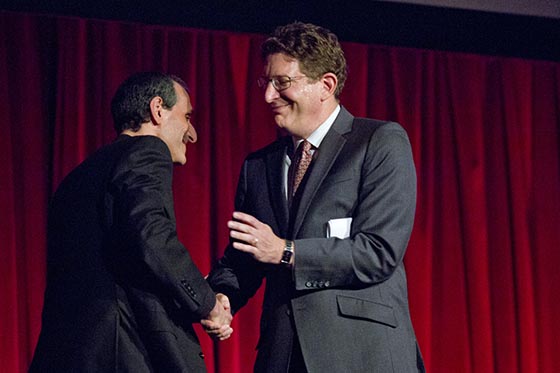
President Jeffrey Herbst, shown here thanking Daniel Benton ’80, P’12, H’10 for his generous support, said: “We have, I believe, entered a virtuous circle where increased financial aid attracts better students who then serve to entice other impressive young people who want to come to a campus where academic excellence is so obvious.”
Thank you! That was the message on April 26, when 750 members of the Colgate community met in New York City to celebrate the end of Passion for the Climb: The Campaign for Colgate.
The campaign gala, rescheduled for spring after Superstorm Sandy hit Manhattan last autumn, featured a series of speakers who celebrated the campaign’s remarkable $480 million success. They spoke of it in terms of Colgate’s past, present, and future, while paying tribute to the 34,519 alumni, parents, and friends who participated.
The university’s first capital campaign took place in 1850, when the Hamilton Village Baptists and fellow citizens sought to raise $60,000 for Madison University. The Northern Baptist Convention Fund Drive of 1920 took in $1 million, and the Bridge to the ’80’s Campaign raised $15 million. Campaign Colgate: The Promise of Leadership dwarfed them all, garnering $130 million by 1997 — until, of course, Passion for the Climb, directed by Murray Decock ’80, vice president for institutional advancement, more than tripled that historic record.
“The fact that we could raise record-breaking totals during a financial crisis — that we could fund an ambitious strategic plan and expand access for so many students — speaks volumes about Colgate alumni, parents, and friends,” Decock said. “We owe them our thanks for their gifts and for rising to the occasion.”
In addition to breaking records, Passion for the Climb exceeded its own initial target. “Setting such a lofty goal was risky,” remembered master of ceremonies Denis Cronin ’69, P’09’10, chair of the Colgate Board of Trustees and campaign chair from 2004–2007. “But we had the Colgate confidence that we could raise $400 million.” Under his watch, Colgate raised the first half of that initial sum.
In 2007, when the campaign went public, James Elrod ’76, P’04’05’12, accepted the torch as campaign chair — only months before recession gripped the globe. The generosity of the Colgate community did not waver: the final tally approached a half-billion dollars, including $142 million for financial aid, when the closing bell rang on June 30, 2012.
The campaign leadership credited President Jeffrey Herbst, who arrived in 2010, with lending new energy to the effort and sharpening the focus on financial aid as a means of preparing the university for the future.
“Universities, including Colgate, are rightfully places to go back to, to celebrate past triumphs, the creation of friendships. They are the places where so much started,” Herbst said. “And yet, schools are inherently forward-looking.”
Projecting that members of the Class of 2017 will be working well into their 80s, he asked rhetorically, “Will we have taught them, prepared them for that future? That, I believe, is the fundamental question that confronts Colgate.”
Passion for the Climb had a transformative effect on campus by raising funds for financial aid, the construction of important new facilities such as the Robert H. Ho Science Center, Case-Geyer Library and Trudy Fitness Center, and endowing academic professorships and institutes.
“I believe that when the history of our time at Colgate is written, the support of all of you — alumni, parents, and friends — have provided to the school will be easily identified as a great turning point by helping to insure our future greatness.”
Daniel C. Benton ’80, P’12, H’10, the tech-savvy hedge fund manager who has created the Benton Scholars program at Colgate and consistently supported financial aid, closed the program by renewing the call to action. It was a Colgate-style challenge, intended to inspire the same determination that saw the university community through a remarkable campaign, stock market crashes — and a superstorm.
“The tech industry has turned its sights on the trillion-dollar education industry,” said Benton, “The stakes have never been higher, and we will continue to need your help.”